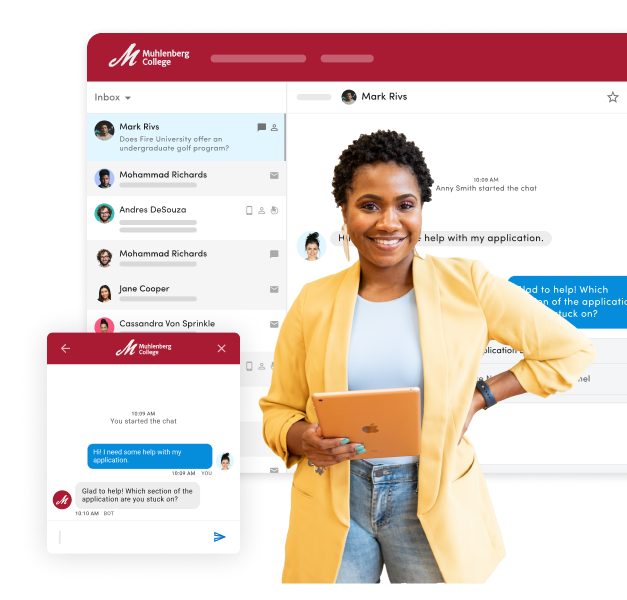Full Guide to Student Engagement in Higher Ed
by Sirley Carballo · Updated Sep 13, 2024

Student Engagement in Higher Education
Element451’s Comprehensive Guide to Personalizing the Student Journey in Higher Ed
•Student Engagement in Higher Education
- What is Student Engagement in Higher Education?
- Pre-Enrollment
- During the Admissions Cycle
- Post-Enrollment
• Improved Student Engagement—Understanding Current Trends
- How Does Engagement Affect Persistence?
• Promote Student Engagement at Your College or University
• How to Improve Student Engagement—Strategies to Implement in Higher Education
- Strategy 1: Personalize Outreach Campaigns
- Strategy 2: Improve Blended Learning Opportunities
- Strategy 3: Engage Students Outside of the Classroom
- Strategy 4: Offer Resources for Holistic Learning and Growth
- Strategy 5: Celebrate Student Wins
• What is a Student Engagement Platform?
- Why You Need a Student Engagement Platform
- Engagement Metrics
- Measuring Engagement Score with Element451
• Helpful Engagement and Student Success Resources
• Increase Student Engagement This Year
From an increasingly competitive education market, to expanded hybrid and remote learning options, to challenges in student participation, college leaders and educators have to get creative. Attracting, recruiting, and keeping the right students engaged is no longer a guarantee.
The good news? When positive innovation collides with modern student expectations, schools have the chance to create a truly remarkable experience in the academic environment. Collectively, these opportunities contribute to one of the most significant goals of higher education—student engagement.
The phrase “engagement” means many different things to various groups of people (including faculty members and other students).
Consider this your go-to spot for all things student engagement, including how to capture student interest and keep it all the way to graduation.
What is Student Engagement in Higher Education?
Because it’s central to the work we perform at Element451, student engagement is a core topic of conversation for our team and for the institutions we serve. For starters, let’s recap our definition for modern higher ed institutions.
Student engagement describes the level and quality of encouragement, support, collaborative learning, and interpersonal communication that students receive throughout the student life cycle, from the moment of initial interest to eventual degree completion.
While it’s true that engaged student personas look different based on specific institutional goals, genuine student engagement leaves tangible clues. In groups of engaged student populations, true connection happens at every single part of the academic journey.
Pre-Enrollment
Whether positive or negative, prospective students and their families start to form opinions in the earliest phases of outreach. From marketing materials to personalized responses, there are a number of ways to engage even before students submit an application.
Examples of increasing engagement pre-enrollment include:
- Personalized marketing messages that cater to specific inquiries
- Individual follow-ups for students who engage with online or in-person admissions materials
- Conversational approaches to common questions and concerns
- Ample opportunities to engage with campus culture prior to moving forward in the admissions cycle
Pre-enrollment sets the stage for future connections. When schools struggle to “win over” a potential student at this stage, it’s even more challenging to capture loyalty later.
During the Admissions Cycle
Once a student submits an application, creating engaging opportunities becomes top priority. A submitted application doesn’t equal an eventual decision, even if that application counts towards admissions goals. “Closing the deal” is only one aspect of ensuring that every student feels known, supported, and valued within this process.
Admissions counselors have a chance to create a memorable and inviting experience, especially as students wait for responses. Depending on the level of competition or the number of current applicants, remember that this stage is highly personal to each future student—and often a little stressful.
Post-Enrollment
After a student decides to enroll, engagement takes on a new look. That’s because a student’s needs become increasingly connected to the college or university, and they’re now part of an exclusive community.
After enrollment, it's good practice to think beyond the time frame of a student’s original admission tasks. Chances to connect include:
- Assistance throughout the financial aid process
- Proactive support through course material selection and registration
- Connection to on-campus social events or activities
- Follow-through from a trusted peer, advisor, or support system
At the post-enrollment stage, students are eager to experience college life to the fullest, but that doesn’t mean that the engagement journey is over. If anything, it means that the responsibility to engage appropriately is simply dispersed among many parties who now actively support the student on the road to success.

Listen to Higher Ed Pulse
Your weekly spotlight on the latest in higher education marketing and enrollment.
Tune In
Improved Student Engagement—Understanding Current Trends
It’s no surprise that the COVID-19 pandemic completely reshaped the way that institutions approached student engagement.
Now, colleges and universities are in a tricky spot—navigating complex challenges that could prevent or hinder new engagement goals. Offering students the emotional and cognitive resources they need requires in-depth planning and awareness.
Over the past few years, administrators, campus recruiters, and admissions team members have faced a slew of trends that are problematic for genuine engagement.
- Fewer in-person engagement opportunities (recruiting activities or fairs)
- Lack of internal staff or resources for recruitment and enrollment
- Shifting student expectations about the need and desire for flexible alternatives
- An ever-growing number of online or hybrid courses for digital classrooms
- The need to provide a “community of care” so that students have access to support
Schools that overcome these challenges are more likely to see higher engagement scores both in and outside class. It takes a collective, campus-wide effort to rebound and recover by leveraging new best practices (including digital trends).
How Does Engagement Affect Persistence?
Students that feel more connected to the campus community are more inclined to enjoy a sense of connection and belonging. But as some higher education research points out, the evidence to these student testimonials is often anecdotal.
Of course, when students participate in sports, clubs, or community events, they’re motivated to perform well in other aspects of the college journey. But school leadership (and individuals in charge of the purse strings) often want tangible data that these sentiments are realistically helpful for retention.
To prove that student engagement encourages persistence, administrators must compromise. Investments in resources (including those that are not directly related to classes or academic life) end up supporting students' level of commitment to degree programs.
In other words, the more engaged a student feels on an emotional and social level, the more likely they are to persist.
Promote Student Engagement at Your College or University
Even growing campuses need leaders who are concerned about boosting engagement through active learning. In a world with abundant digital chatter, it’s easy to be present in a busy place without experiencing genuine connection.
Student engagement strategies offer numerous benefits to schools at all levels of growth and throughout every stage of enrollment.
- More incoming inquiries and interested students during recruitment
- Higher number of completed and submitted applications per term
- Student-campus alignment for those students who do enroll
- Greater persistence and retention percentages in an academic program
- Overall academic success throughout various learning experiences
There are student-centric benefits as well, including the chance to nurture those who aren’t simply equipped for the academic future, but who have practical support in other areas of their personal and professional lives.

How to Beat the Top 6 Recruiting Challenges
Get our guide and be on your way to solving problems and connecting with prospects more meaningfully than ever before.
Get the Guide
How to Improve Student Engagement—Strategies to Implement in Higher Education
EduCause Review points out that educators have had to adapt rapidly in a short time. From switching to online learning, to finding ways to personalize on campus courses more adequately, these challenges highlight the need to stimulate engagement on a deeper level.
Considering the current landscape, should most institutions continue to increase student engagement? Of course. Here’s how to get started using proven methods.
Strategy 1: Personalize Outreach Campaigns
Today’s college students are savvy and well-informed. They already know how to navigate digital marketing practices, and they’re not strangers when it comes to receiving individualized messaging from other sources.
If brands and businesses are personalizing outreach to the current generation, shouldn’t your institution do the same?
Personalized messaging starts when students submit their first inquiry form—online or in person. Marketing messages should then flow to the student in a timely and helpful manner. Consider what the student needs to know (an upcoming deadline or invitation details) and provide in-depth information that builds a positive and trustworthy experience.
Remember—personalization now paves the path to a better learning experience later.
Strategy 2: Improve Blended learning Opportunities
According to recent reports and student interviews, nearly a third of today’s students favor a hybrid model for college learning. The flexibility of new methods is appealing, but the personal touch that connects students to on-campus resources is still beneficial. It's a real challenge to achieve this, especially for faculty members and instructors.
Although schools might have concerns about how to handle such a complex “menu” of course offerings, learning how to mix and integrate these into the campus experience is crucial.
Optimal student learning and engagement begins when schools know how to keep pace with technology and can offer flexible solutions accordingly.
Strategy 3: Engage Students Outside of the Classroom
Of course, students enroll in college to learn and receive a degree. But it goes without saying that there’s much more to the university experience than textbooks and lectures.
Schools that have well-rounded extracurricular or campus offerings are on a better path toward relational engagement. From clubs, to sports, to residential leadership opportunities, engaging students outside of the traditional classroom builds bridges to better relationships.
When these relationships are well-established, it may be easier for schools to spot red flags, like when students are at-risk for not graduating. When students have a reliable network, they may be more inclined to fall back on that support network when times get tough.
Strategy 4: Offer Personal Resources for Holistic Learning and Growth
An appropriately engaged campus is one that offers academic, mental, social, and physical resources at any given time.
It’s true that tuition dollars aren’t necessarily just about having fun—or even about offering the emotional and psychological resources that students may request. But if the college experience is about nurturing the entire individual (including who that person becomes once they graduate with a degree), then investing in proactive resources is an obvious choice.
Strategy 5: Celebrate Student Wins
One of the most positive and affirming ways to boost student engagement is to celebrate the success of your students along the journey. From the initial application and entrance to the completion of particular courses, students have a lot to manage and juggle.
Promote good conversations among students about what it means to perform well and persist. Celebrate accomplishments in different contexts across campus. Use student stories to inform prospective students about what it means (and looks like) to win—even if that success doesn’t necessarily look like a traditional or stereotypical picture of success.
These efforts contribute to the diversity of your campus. In turn, you’ll reap the rewards of having attendees who know that they’re valued and respected.
What is a Student Engagement Platform?
A student engagement platform is a comprehensive software or CRM (customer relationship management) tool that allows you to manage student interactions in detail. An engagement platform like Element451 makes it easy to manage communications with future and current students through outlets like email, text, and chat.
A modern student engagement platform is extremely beneficial for managing tasks related to marketing, outreach, admissions, and enrollment. Within one intelligent platform, you’ll be able to finetune your multi-channel approach to student engagement and see results and analytics in real-time.
Why You Need a Student Engagement Platform
If you’ve got hundreds of hours to spend on manual marketing and engagement tasks, then you might not need a full-scale student engagement platform. But in our experience, very few schools have limitless resources or personnel.
That’s why engagement platforms are so powerful for growing a student body. A comprehensive CRM tool connects the dots between student communications and staff members, making it easier to engage today’s college applicants.
Your school could benefit from an engagement platform if:
- You want to take advantage of competitive tools and features, including AI-powered chatbots and powerful automations
- Personalization is a top priority in your marketing and outreach goals
- Admissions team members want to deliver individualized attention to new students, while saving critical time and effort
- You’ve tried separate, disjointed communication and marketing tools but want to want to bring everything into one simplified platform
Engagement Metrics
As colleges and universities develop new strategies, identifying key performance indicators (KPIs) is important. Although we agree that not all engagement is quantifiable, it helps to know your starting point.
Here are a few basic metrics that we recommend based on experience with campus engagement and growth.
- Turnover rate – From a marketing perspective, turnover refers to the number of inquiries or applicants that you lose over a period of time, such as in one semester. When you compare this to the number of opportunities you convert (or enroll), you’ll have a rate that helps you gauge campaign success.
- Application percentage – Consider how many students actually submit applications out of the total number of inquiries. When you divide applicants by total students, you’ll have an application rate that informs your admissions approach.
- Enrollment rate – Next, divide the number of students who enroll by the number of approved or accepted applications. This gives you an enrollment rate, which may differ greatly based on factors like competition, available seats, or financial requirements.
- Retention rate – Retention rates are often determined annually by dividing the number of retained students by the number that originally enrolled. Reviewing 12-month retention rates for several years is helpful when looking for generational trends or issues among student cohorts.
Measuring Engagement Score with Element451
With Element451, school staff members can quickly spot an individual student’s engagement score, based on the level of activity throughout an enrollment cycle. Higher scores highlight which students are well-connected, while lower scores indicate at-risk scenarios that warrant prompt attention or follow-up.
Element451’s combination of scores and phrasing help schools identify who is a “stranger” and who is a “fan” based on certain behaviors (like replying to an SMS). Additionally, you'll get insightful data on when students prefer to communicate, which messages are most engaging, and how to segment your audience.

Get a Demo of Element451
Enhance student engagement and boost satisfaction—all while streamlining your administrative team's workload—with the only higher education solution you'll ever need.
See it in Action
Helpful Engagement and Student Success Resources
At Element451, we provide the most up-to-date resources and online discussions for universities that want to focus on engagement. From blog posts to webinars, you’ll find a comprehensive selection of resources on the topic.
Check out the resources below to expand your engagement perspective and reshape the way your school engages with modern learners.
Increase Student Engagement this Year
When you have strategic vision and combine that with powerful tools and software, you'll revolutionize your learning environment.
Element451 assists teams by making those engagement goals possible. With personalized campaigns and student-focused experiences, your school can attract the right students to fill open seats—and see them through to graduate.
It’s time to modernize the higher education journey for more students. Let’s do it together.

About Element451
Boost enrollment, improve engagement, and support students with an AI workforce built for higher ed. Element451 makes personalization scalable and success repeatable.
Categories
New Blog Posts

The Definitive Guide
AI in Higher Education
Bridge the gap between the latest tech advancements and your institution's success.
Useful Links

Talk With Us
Element451 is the only AI Workforce Platform for higher education. Our friendly experts are here to help you explore how Element451 can improve outcomes for your school.
Get a Demo








